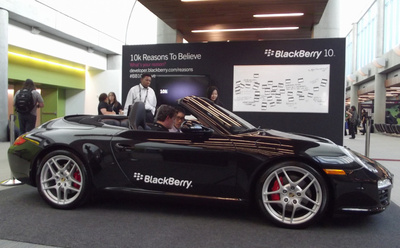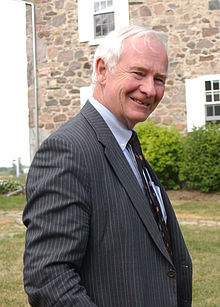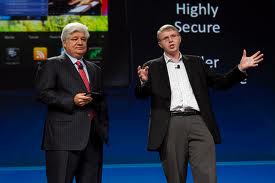The founder of QNX is confident that the BlackBerry 10 will be impressive
 When Dan Dodge ( Dan Dodge ) was asked at the BlackBerry Jam Americas (San Jose, California) conference how he feels now that the future of Research In Motion (RIM) is in his hands, he replied that he believed in success.
When Dan Dodge ( Dan Dodge ) was asked at the BlackBerry Jam Americas (San Jose, California) conference how he feels now that the future of Research In Motion (RIM) is in his hands, he replied that he believed in success.Dan Dodge talked about the QNX operating system , which will become the engine and transmission of the new BlackBerry 10 smartphone. The OS was developed by a company founded by Dodge two years after graduating from the University of Waterloo in 1979, which Dan completed with degrees in mathematics and computer science. Over the next 19 years since its founding, Dodge - QNX has become a company with more than 200 employees, with major customers in the automotive industry, online networks, casinos, and even books retailers. “What we create is unlike anything,” said the CEO of QNX Software Systems . “This is truly unique and exceptional.”
“It’s hard to buy a car without a QNX system installed in it,” Dodge said in an interview at the BlackBerry Jam conference. And as if, to confirm these words, a black Porsche equipped with QNX was demonstrated at the conference.
')

At the BlackBerry Jam Americas conference in San Jose, California, Porsche was introduced, equipped with a QNX RTOS - under which the BlackBerry 10 smartphone will operate.
QNX works on the OnStar security system , which notifies General Motors when one of its customers has trouble on the road or any airbag is triggered. QNX OS also manages in-car entertainment systems and its speakerphone for mobile phones.
QNX, mission-critical software, manages switches and routers in Cisco's huge network systems and slot machines in Las Vegas casinos. "People use QNX where the cost of a mistake is very high," said Dan Dodge, who assembled his first computer while living in a university campus at UW (University of Waterloo) . "People are looking for reliability, and this is one of the reasons why automakers love us so much."
 Located in Ottawa, QNX would have followed its successful path, which has nothing to do with the world of smartphones, if it had not been for an accidental turn of events three years ago. In 2004, QNX was acquired by Harman International Industries , a major American media company that produces audio and infotainment systems for cars, homes and theaters. Harman provided QNX with more freedom, and even allowed its competitors to sell software. However, by 2009, some of QNX’s customers began to complain that their main suppliers belong to a competitor. In this situation, Dodge offered to resell QNX to another company. One of the firms on the QNX shortlist was RIM. Dodge asked David Johnston ( David Johnston ), who was the president of UW at the time, to arrange a meeting with the founder of RIM, Mike Lazaridis . “He really liked what he saw,” Dodge said about Lazaridis. The transaction took place in record time, and was closed in spring 2010.
Located in Ottawa, QNX would have followed its successful path, which has nothing to do with the world of smartphones, if it had not been for an accidental turn of events three years ago. In 2004, QNX was acquired by Harman International Industries , a major American media company that produces audio and infotainment systems for cars, homes and theaters. Harman provided QNX with more freedom, and even allowed its competitors to sell software. However, by 2009, some of QNX’s customers began to complain that their main suppliers belong to a competitor. In this situation, Dodge offered to resell QNX to another company. One of the firms on the QNX shortlist was RIM. Dodge asked David Johnston ( David Johnston ), who was the president of UW at the time, to arrange a meeting with the founder of RIM, Mike Lazaridis . “He really liked what he saw,” Dodge said about Lazaridis. The transaction took place in record time, and was closed in spring 2010. The initial plan of Lazaridis for QNX was the creation of an operating system for the PlayBook , the RIM tablet. That was when it was not yet determined whether QNX would be in the next generation of BlackBerry smartphones. “At first we had to show ourselves on the tablet,” said Dodge. “But as soon as we established ourselves there, we got full leverage for the phones.”
The initial plan of Lazaridis for QNX was the creation of an operating system for the PlayBook , the RIM tablet. That was when it was not yet determined whether QNX would be in the next generation of BlackBerry smartphones. “At first we had to show ourselves on the tablet,” said Dodge. “But as soon as we established ourselves there, we got full leverage for the phones.”Dodge was outraged by the criticism that initially the PlayBook was not competitive. “The PlayBook sells exceptionally well and outperforms the Samsung Galaxy tablet,” he said. “The only mistake RIM made was launching a tablet without enough apps or games,” says Dodge. "It is unpleasant. But RIM has fixed the situation with the release of the PlayBook 2.0 update, for which there is a “huge number of applications,” including several big names in the field of the gaming industry, ”Dodge said.
Dan Dodge also rejects the view that RIM made a mistake without making an email in the first version of the PlayBook. “It was easily accessible, simply by connecting the BlackBerry to the PlayBook,” he said. “We thought it was actually the best solution, because what are two emails for when you really only need one?” But when users started complaining, and RIM was criticized in the media, the company went forward and included email in the PlayBook 2.0. It all ended up being a blessing in disguise, ”said Dodge,“ because the email system in the new BlackBerry 10 “originated in the tablet.”
Not surprisingly, RIM eventually decided to create a completely new operating system for smartphones, Dodge said. He explains that the BlackBerry, released in 1999, was created primarily as a communication device for handling such things as email. When smartphones became more functional and were able to cope with a variety of applications and quickly browse the Internet, they essentially became mobile computing platforms, rather than e-mail systems.
“Initially, RIM’s operating system was not designed for this,” said Dodge. “To try to do this would be too difficult, perhaps even impossible. And then the company decided that they should create a new system that could handle what is expected in the next generation of smartphones, ”he said. “This is what we have done. We had an industrial, high-performance, reliable operating system that could compete with iOS (the iPhone operating system.) The key advantage of the QNX operating system is that it uses a “microkernel” architecture . Instead of a "monolithic" performance, like many software platforms, it breaks the system down into smaller components so that you can easily add new functions or rewrite code for new applications. Monolithic systems, such as RIM's old BlackBerry platform, could not cope with new opportunities, because the old development is no longer relevant, and the system has become so complex and poorly coordinated with new capabilities that no one understood them. At the same time, monolithic operating systems become poorly structured ( "spaghetti-like" ) and are very resistant to change. Even worse, they cannot be broken down into components to safely accommodate all the new additional features, ”said Dodge. “It’s easier to add a component to a system built like a Lego designer than to a one that is poured like a concrete slab.”
Dodge rejects the conclusions of some analysts that RIM did not show anything new at BlackBerry Jam Americas that it would not be used in other smartphones. “I was approached by several analysts and other people, and they were impressed with how RIM was developing BlackBerry 10. In the end, everything will be clear when entering the market, and if the market appreciates our contribution to it, we will do it exceptionally well” , he said. “And if the press and analysts give us a break and write a few positive articles, it will certainly also help.”
Focusing on RIM products also means a big change in QNX. Several hundred employees still support former customers, primarily automotive manufacturers. But most QNX engineers, backed by RIM employees, work primarily on the BlackBerry PlayBook, and now on the BlackBerry 10.
// The Record
Source: https://habr.com/ru/post/154727/
All Articles